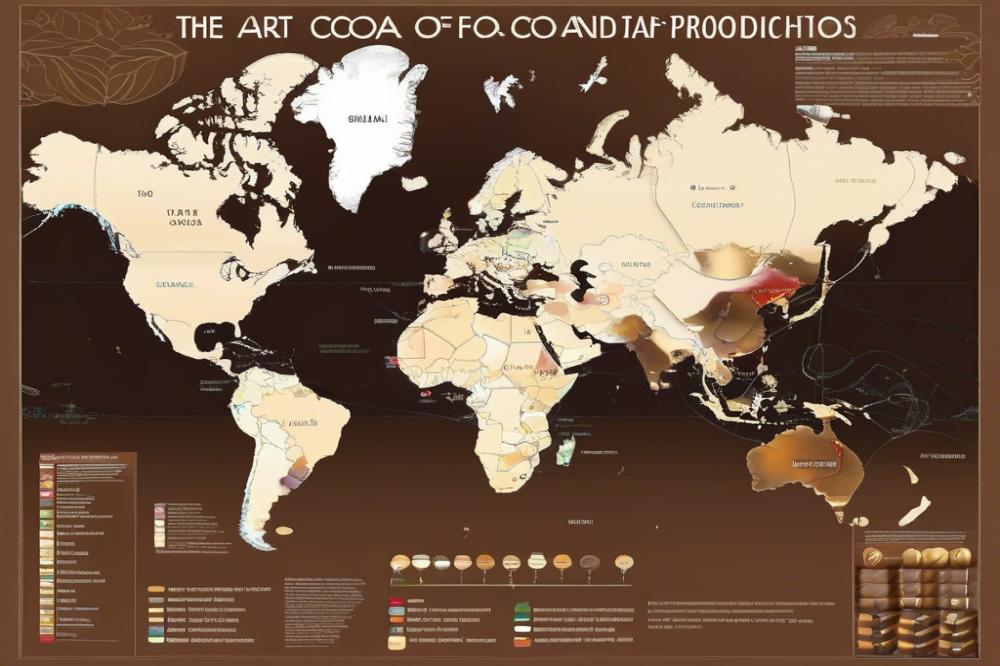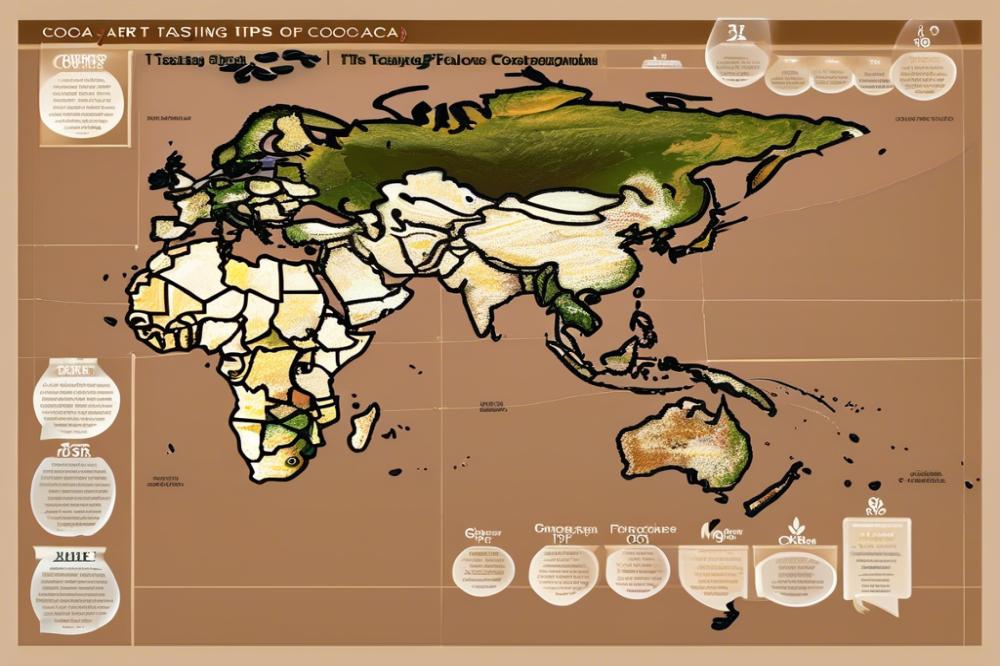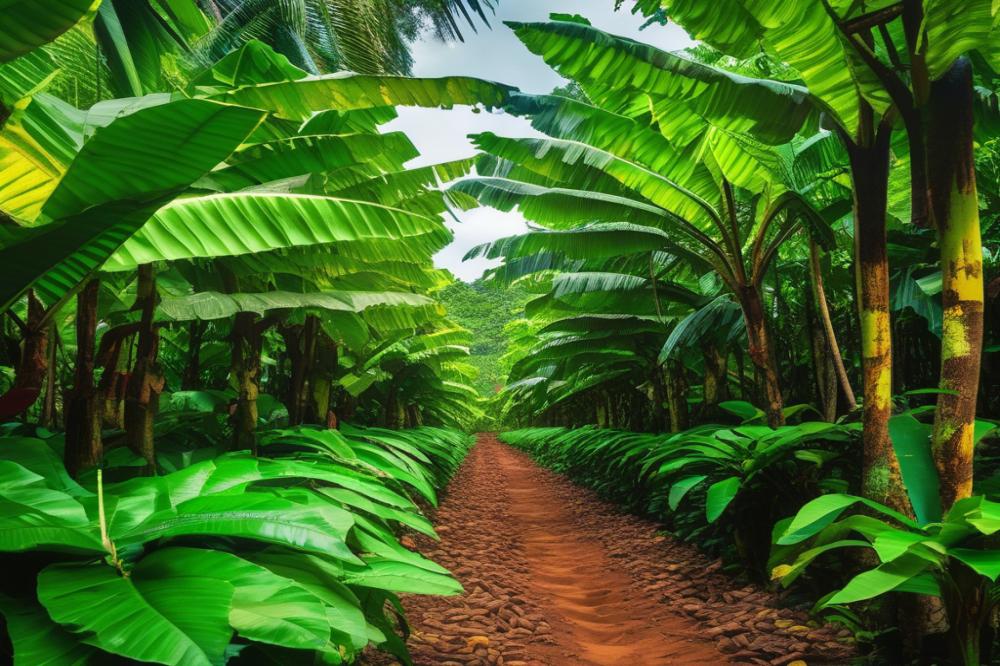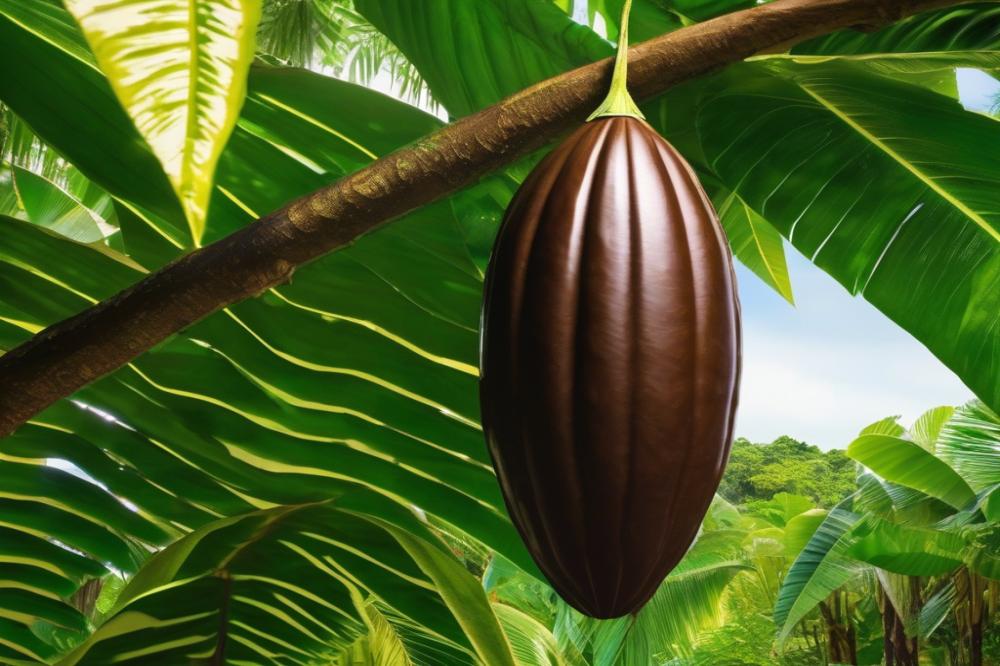The Art of Tasting Cocoa: Tips for Discerning Flavors
chocolatebix.com/exploring-the-different-types-of-cocoa-beans”>chocolate lovers rejoice! chocolatebix.com/health-benefits-of-cocoa-why-it-s-good-for-you”>cocoa tasting is an essential aspect of appreciating the rich world of chocolate. Many people enjoy chocolate, but few take the time to truly understand the layers of flavor found in each bite. By diving deeper into the tasting experience, one can uncover hidden tasting notes that transform a simple treat into a journey through the senses.
The journey of cocoa begins with the cacao tree, which produces cocoa beans. These beans are harvested, fermented, dried, and roasted before they become the chocolate we savor. Each step in this process impacts the final product’s taste and aroma. For anyone curious about the nuances of chocolate, this journey is vital to grasp. The transformation from bean to bar is a complex art that significantly influences chocolate’s unique flavor profiles.
Understanding chocolate requires an appreciation for sensory evaluation. This involves engaging all senses: sight, smell, taste, and even touch. Noticing the aroma of chocolate before tasting it can enhance the overall experience. By utilizing chocolate tasting techniques, one can better discern various flavors and textures. Utilizing a flavor wheel can help tasters identify specific notes, making the experience more enjoyable. Over time, anyone can develop their palate, becoming more adept at distinguishing the subtle differences between craft chocolate varieties.
Understanding Cocoa Beans

Different Types of Cocoa Beans and Their Origins
Cocoa beans come from various regions across the globe. The three main types are Criollo, Forastero, and Trinitario. Criollo beans are often considered the finest. They thrive in regions like Venezuela and Ecuador, providing a rich and delicate taste. Forastero beans dominate the market due to their hardiness and yield. These grow primarily in West Africa and come with a more robust flavor. Then there’s Trinitario. This hybrid bean combines the best traits of both Criollo and Forastero and is known for its complex flavor profiles.
The Impact of Terroir on Flavor Profiles
Terroir significantly influences the taste of chocolate. Factors such as soil type, climate, and altitude shape the final product. For instance, beans grown in volcanic soil can have a very distinct flavor. Regions like Madagascar produce bright, fruity notes, while those from Ghana are known for their earthy undertones. When evaluating cocoa, understanding where the beans come from can enhance your sensory evaluation. Each origin tells a story through its unique tasting notes.
The Role of Fermentation and Drying Processes on Taste
Fermentation is crucial for developing rich flavors. After harvesting, cocoa beans undergo fermentation for several days. This process breaks down the sugars and begins to develop the cocoa’s aroma. If done correctly, fermentation brings out complex flavors. Following fermentation, the drying process ensures the beans are prepared for storage. Improper drying can lead to off-flavors that detract from the tasting experience. A well-crafted chocolate bar is the result of careful attention to both fermentation and drying techniques.
Exploring these elements can greatly enhance your chocolate tasting techniques. Pay attention to the flavor wheel as you savor different chocolates. By honing your palate, you will discover the diverse world of cocoa beans. Preparing to appreciate craft chocolate involves understanding these foundational factors. Each aspect contributes to an enriching tasting journey.
The Chocolate Flavor Wheel

The flavor wheel is a simple yet powerful tool in the world of chocolate tasting. By using it, you can unlock different attributes of chocolate. It is designed to represent a variety of flavors and aromas that emerge from cocoa beans. With sections that range from fruity and floral to nutty and earthy, the flavor wheel acts as a guide during your tasting journey.
How to Use the Flavor Wheel in Tasting
To benefit from the flavor wheel, start by observing the chocolate piece you will taste. Take a moment to appreciate the appearance, as this can give hints about the flavor profile. Once you take a bite, let it melt in your mouth. Pay close attention to how the chocolate unfolds. A range of tasting notes may begin to reveal themselves. As you identify these notes, refer back to the sections of the flavor wheel. Doing this enhances your sensory evaluation, helping you deepen your understanding of craft chocolate.
Common Tasting Notes Found in Various Cocoa Types
Different cocoa types present varying tasting notes. Some beans offer strong fruity flavors, resembling citrus or berries. Others might bring out a nutty taste reminiscent of almonds or hazelnuts. You may also encounter floral and herbal notes that offer a refreshing twist. Earthy undertones can give depth, often reminding tasters of coffee or spice. With each variety, the tasting experience becomes richer, broadening your palate development. Embracing these diverse flavors transforms the act of tasting into a delightful adventure.
cocoa tasting Techniques

Step-by-step guide to tasting cocoa
Start by selecting high-quality chocolate or cocoa beans. Look for craft chocolate that piques your interest. A calm environment enhances the experience. Begin by breaking the chocolate into small pieces. Observe its shine and snap. Take a moment to let the aroma fill your senses. This first stage is crucial for savoring flavors later.
Next, place a small piece on your tongue. Allow it to melt slowly. As it dissolves, pay attention to the textures. Certain varieties create a rich, creamy sensation. Others might feel gritty or rough. Each texture adds another layer to the tasting experience.
Don’t forget to chew slightly. This action releases more flavors. Think about the initial taste and what hits your palate first. Is it bitter or sweet? As you explore further, observe the aftertaste, known as the finish. This lingering sensation can reveal hidden tasting notes.
Importance of aroma in the tasting experience
Aroma plays a key role in how we perceive flavors. The nose contributes significantly to our overall enjoyment. As you taste, bring the chocolate close to your nose and inhale deeply. You may detect hints of fruit, spice, or even floral notes.
A brief pause can help enhance your sensory evaluation. Recognize that aromas can change as the chocolate melts. These nuances make the tasting journey more exciting. Don’t rush through this step. Take time to appreciate how the aroma interacts with flavor.
Techniques for enhancing palate development
Improving your palate is an ongoing journey. One effective technique is to regularly sample different chocolates. Comparing flavors helps you recognize subtle differences. Use a flavor wheel to guide your tasting notes. This tool can articulate what you experience more clearly.
Another idea is to keep a tasting journal. Documenting your thoughts can sharpen your focus over time. Following this practice leads to a deeper appreciation. Invite friends to join you in tasting sessions. Shared experiences can spark discussions about flavor profiles.
Finally, consider trying chocolates that contain a range of cocoa percentages. This variety will help expand your understanding of how cocoa beans influence taste. Each percentage brings out distinct qualities, enhancing your palate development.
Craft Chocolate vs. Mass-Produced Chocolate
When comparing craft chocolate to mass-produced chocolate, the differences become clear quickly. Flavor profiles vary significantly. Craft chocolate often offers a rich array of tasting notes, while mass-produced versions tend to be one-dimensional. This is due to the methods used in production. Artisanal methods, which emphasize quality and care, play a significant role in developing complex flavors.
Aroma is an essential part of the tasting experience. With craft chocolate, the scent may be more fragrant. You might detect hints of fruits, spices, or even floral notes. These aromas prepare the palate before any tasting begins. Mass-produced chocolate typically lacks this depth. The careful selection of cocoa beans used in craft chocolate elevates the overall sensory evaluation.
Sourcing affects flavor too. Many craft chocolatiers seek out high-quality beans grown in ideal conditions. They often work closely with farmers to ensure ethical practices. Good sourcing leads to better flavor and overall quality. In contrast, mass-produced chocolate can use lower-grade beans. This practice can diminish the tasting experience, leading to a bland product.
Production methods also make a difference. Craft chocolate makers often use traditional techniques, allowing for greater expression of the beans’ natural characteristics. It is common for them to experiment with fermentation and roasting. These methods contribute to a range of flavors. Therefore, understanding chocolate tasting techniques is crucial for the discerning taster.
The flavor wheel can be a helpful tool when assessing flavors. It categorizes various tastes and aromas, making it easier to describe your findings. As you develop your palate, using this tool can enhance your appreciation for chocolate. Craft chocolate opens doors to a variety of experiences, unlike anything mass-produced can offer.
Engaging Your Senses
Creating an Ideal Tasting Environment
Finding the right atmosphere is essential for chocolate tasting. A well-lit, comfortable space allows you to focus. Dim lighting or distractions can alter your perception. Remove strong odors, as they can overpower the subtleties of aroma. Use neutral backgrounds, such as white plates, to highlight the chocolate’s colors. Soft music can help set a relaxed mood but avoid anything too loud that might disrupt your thoughts.
Immersing Yourself in the Tasting Experience
To truly appreciate each sample, begin by slowing down. Take a moment to observe the piece of craft chocolate. Notice its sheen and texture. Break the chocolate and listen for that satisfying snap. This sound indicates quality and freshness. Before tasting, bring the chocolate close to your nose. Inhale deeply, allowing the aroma to wash over you. Think about the different scents you might identify, such as spices, fruit, or even floral notes. This step lays the foundation for your tasting notes.
The Role of Sight, Smell, and Taste
Three key sensory elements come into play during this process. Sight provides the first impression. A glossy surface suggests a well-tempered chocolate. Colors can hint at the variety of cocoa beans used. Next comes smell, a crucial part of sensory evaluation. Aromas might include roasted nuts or hints of vanilla. These scents open a window into the flavors awaiting your palate.
Tasting is where it all comes together. Take a small piece and let it melt on your tongue. Observe the texture, whether it’s silky or gritty. As it dissolves, pay attention to the flavors that emerge. Use a flavor wheel to help identify what you’re experiencing. Notes of caramel, coffee, or even citrus might surprise you. Each tasting session enhances your palate development.
Chocolate tasting techniques may vary, but the core experience remains the same—engaging your senses deeply transforms ordinary chocolate into a journey through complex flavors. Enjoy each moment of this tasting adventure, as the world of chocolate awaits your exploration.
Finding the Right Cocoa for You
Personalizing your cocoa tasting journey can be an exciting adventure. Each type of chocolate carries distinct properties. The first step is to explore different kinds of cocoa beans. There are many varieties, including those from Madagascar, Ecuador, and the Caribbean. Each origin offers flavors ranging from fruity to nutty. Pay attention to the details as you taste.
Tips for Discovering Flavors You Enjoy
Engaging in sensory evaluation will enhance your experience. Start with examining the aroma. Swirl the chocolate gently and take a good whiff. This initial step reveals essential hints about what you might expect. Next, let pieces melt slowly on your tongue. Note the different tasting notes that emerge. A flavor wheel can be an excellent tool for mapping these flavors. Consider what pleases your palate as you savor chocolate.
Experimenting with various brands is key to your journey. Seek out craft chocolate makers who emphasize quality ingredients. Brands that focus on ethical sourcing often highlight their bean origins. This enhances flavor complexity. Look for those who provide tasting notes on their packaging. These insights help create a richer understanding of what’s inside.
Recommended Brands and Resources for Further Exploration
Some popular brands include Alter Eco, Taza, and Askinosie. These makers produce unique chocolate varieties that can widen your palate development. They often share resources to improve your chocolate tasting techniques. For further exploration, consider joining a local chocolate club or attending classes. Personal experiences shared with other enthusiasts can offer valuable tips. Additionally, online communities can be great places for advice and recommendations.
A Sweet Journey Awaits
Exploring the world of cocoa flavors adds a rich layer to enjoying chocolate. It transforms a simple treat into an adventure for the senses. Engaging in this practice helps us appreciate the complexity found in different chocolate types. Knowing how to identify various notes can turn any chocolate break into a mini celebration. Tasting isn’t just about eating; it’s an experience that fosters connection to the ingredients and the makers.
Learning these skills can take time, but don’t let that discourage you. Dive in and savor each bite. The more you practice, the better you will become at discerning flavors. Maybe you will detect hints of fruit, spice, or even floral undertones. Every session of sensory evaluation offers new discoveries, and each sample could surprise you.
Chocolate is more than a treat; it’s an art form. By dedicating time to this craft, you can cultivate a deeper appreciation for what you consume. Remember, every flavor presents a story. This journey invites you to become a part of that narrative. So grab a few different chocolates, perhaps with a friend, and start tasting. Enjoy the exploration that awaits you!



